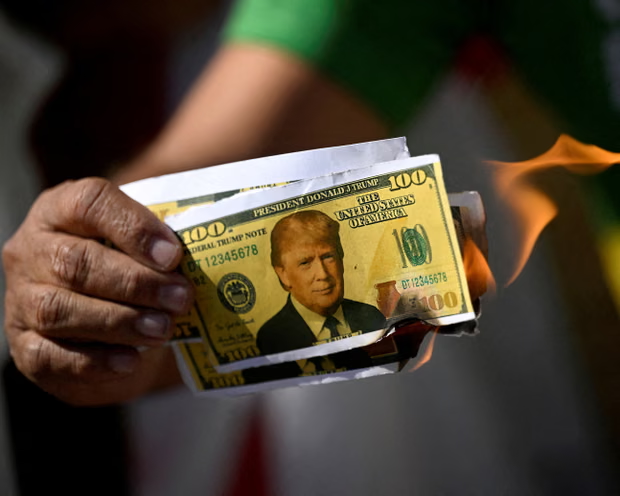While Trump Shouts ” Make America Great “, Wall Street reels under Trump’s policies with losses topping $1T. Explore how tariffs, market volatility, and fiscal chaos are reshaping U.S. markets.
A New Wave of Turbulence
In early 2025, U.S. equities faced one of their sharpest downturns in years as former President Trump rolled out sweeping tariff policies. The impact was immediate: from early April to mid-March, the S&P 500 slumped nearly 9%—erasing over $4 trillion in market value, MoneyWeek+15. Adding to the shock, analysts later reported losses exceeding $1.7 trillion after Trump refused to rule out a recession, sending investor sentiment into freefall, Al Jazeera.
The Flashpoints Behind the Decline
Political and Trade Volatility
On April 2, 2025, dubbed “Liberation Day,” Trump imposed new tariffs—raising average U.S. rates to historically high levels in decades. The sudden announcement triggered market chaos and a broad sell-off across global indices Yahoo Finance. The S&P 500 plunged more than 10% in just two trading sessions and wiped out nearly $7 trillion in global stock market value by early April Kiplinger.
Economic Fallout and Policy Reversals
Tariffs applied to $2.3 trillion of U.S. imports by May 2025—covering 71% of all goods imports, creating regulatory whiplash and supply chain shocks for businesses dependent on global sourcing AP News. Inside the U.S., factory input costs rose by 2%–4.5%, squeezing margins and threatening job security in manufacturing-heavy states AP News.
Fiscal Pressures and Market Confidence
The administration’s “One Big Beautiful Bill” promised permanent tax cuts and sweeping spending shifts—projected to raise the federal deficit by $3.4 trillion and balloon long-term debt to $60 trillion by 2035 MoneyWeek. Combined with political interference—such as firing the Bureau of Labor Statistics chief after downward job revisions—these moves shook investor confidence further Barron’s.
Could Losses Hit $1 Trillion?
Definitely—but it might already be well beyond that. Early estimates placed losses around $4 trillion in core U.S. indices alone Reuters. Some global estimates tallied $7 trillion wiped out in days following tariff shocks, and a $10 trillion loss globally when factoring in EU market drops—far exceeding the oft-cited $1 trillion threshold.
Experts caution that continued policy uncertainty, mounting debt, and waning confidence could drive additional declines, potentially hitting or surpassing that $1 trillion figure again in future downturns.
Why the U.S. Still Looks Resilient—for Now
Despite steep early 2025 losses, markets have rebounded: as of July 2025, the S&P 500 had recovered and posted over 28% gains since April lows, even hitting record highs at usbank.com. GDP grew at 3% in Q2 2025, exceeding expectations of ~2.4%, and avoided a broader recession—though blemished by softening jobs data and slowing growth in July. The Guardian.
Yet investor sentiment is fracturing: nearly half of institutional investors now report reducing U.S. exposure, citing trade uncertainty, declining confidence in labour data, and dollar weakness, Reuters.
Threats on the Horizon
- Political risks—interference in Fed oversight, data credibility, and escalating tariffs raise systemic caution The Washington Post.
- Fiscal risks—mounting debt, rising inflation, and weakened social safety nets may trigger long-term economic drag MoneyWeek.
- Structural risks—tariffs and global realignment challenge U.S. competitiveness in advanced sectors like semiconductors, medical devices, and automotive .
What Investors Need to Do
- Diversify globally—consider non-U.S. and emerging market exposure as a hedge KiplingerReuters.
- Monitor policy shifts—tariff announcements, Fed independence, and fiscal legislation will impact markets swiftly.
- Adopt long-term thinking—avoid emotional trading during volatility cycles, and focus on fundamentals.
- Hedge via strategy—use defensive sectors, inflation protection, and balanced fixed income exposure.
Final Thoughts
The notion that Trump’s policies could cost U.S. markets $1 trillion is not just plausible—it’s already supported by data showing multiple trillions in losses. While a rebound may offer hope, vulnerability remains high if volatility re-emerges. Navigating this era requires both caution and strategic foresight. Thoughtful investing, clear policy pathways, and global coordination are essential to mitigate further economic damage.
Markets may recover, but complacency could cost billions more—perhaps not today, but tomorrow. Vigilance remains key.
WallStreet #TrumpEconomy #StockMarketCrash #USMarkets #Tariffs2025 #EconomicVolatility #FinancialCrisis #InvestorStrategy #MarketLosses #GlobalEconomy

